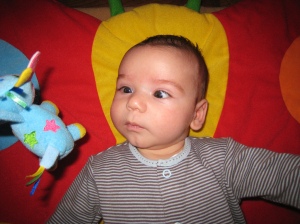HELP! It looks like my child’s eye is turning in, or out or I’m not sure. What do I do? What is strabismus anyway?
Strabismus, or crossed eyes, is a condition in which both eyes do not look at the same place at the same time. It occurs when an eye turns in, out, up or down. Strabismus is classified by the direction the eye turns:
• Esotropia = Inward turn
• Exotropia = Outward turn
• Hypertropia = Upward turn
• Hypotropia = Downward turn
There are six muscles attached to each eye that control eye movement. Normally, the eyes work together so both eyes look at the same place at the same time. An eye turn may be visible when there are problems with eye movement control.
The eye turn may be present constantly or only at certain times such as when the person is tired, ill, or has done a lot of reading or close work. One eye or both eyes may alternate turning.
Proper eye alignment is important to avoid seeing double, for good depth perception, and to prevent the development of poor vision in the turned eye.
What causes strabismus?
There are many causes, including:
- Eye muscle problems.
- Problems with the nerves that transmit information to the muscles.
- Trouble with the control center in the brain that directs eye movements.
- General health conditions or eye injuries.
What are risk factors for developing strabismus?
- Family history – Those with parents or siblings who have strabismus are more likely to develop it.
- Refractive error – Especially a large amount of uncorrected farsightedness (hyperopia).
- Medical conditions – Including Down syndrome, cerebral palsy, stroke or head injury.
How is strabismus diagnosed?
Strabismus is diagnosed through a comprehensive eye exam. Testing may include:
- Visual acuity, or vision – “Normal” distance visual acuity is 20/20.
- Refraction – Determine the appropriate lens power needed to compensate for any refractive error (nearsightedness, farsightedness, or astigmatism).
- Alignment and focusing testing – How well the eyes focus, track, move and work together.
- Examination of eye health – This includes the front and back of the eyes. Eye pressure is also evaluated.
Because vision may change frequently during the school years, regular eye and vision care is important.
How is strabismus treated?
There are several treatment options to treat strabismus, including:
- Eyeglasses or contact lenses – For some conditions, glasses alone will align the eyes.
- Prism lenses – Prisms align the images seen by both eyes, so the eyes can fuse or see the same image, restoring visual clarity and depth perception.
- Vision therapy – Vision therapy trains the eyes and brain to work together more effectively.
- Eye muscle surgery – Surgery may be able to physically align the eyes so they appear straight. A vision therapy program may also be needed after surgery.
What can happen if the eye turn is not treated?
Potentially an untreated eye turn can lead to amblyopia, otherwise known as lazy eye. Amblyopia is permanently reduced vision in one eye.
When does a child develop strabismus?
Typically strabismus develops in infants and young children by age 3. It may be present in older children and adults. Children do not “outgrow” strabismus.
Most importantly…
If detected and treated early, strabismus can often be corrected with excellent results. Eye examinations are important for all children and adults, starting at 6 months of age. If any eye turn is in question, schedule a comprehensive eye examination immediately.
~Melissa Barnett, OD, FAAO
California Optometric Association
http://www.eyehelp.org
http://www.coavision.org

